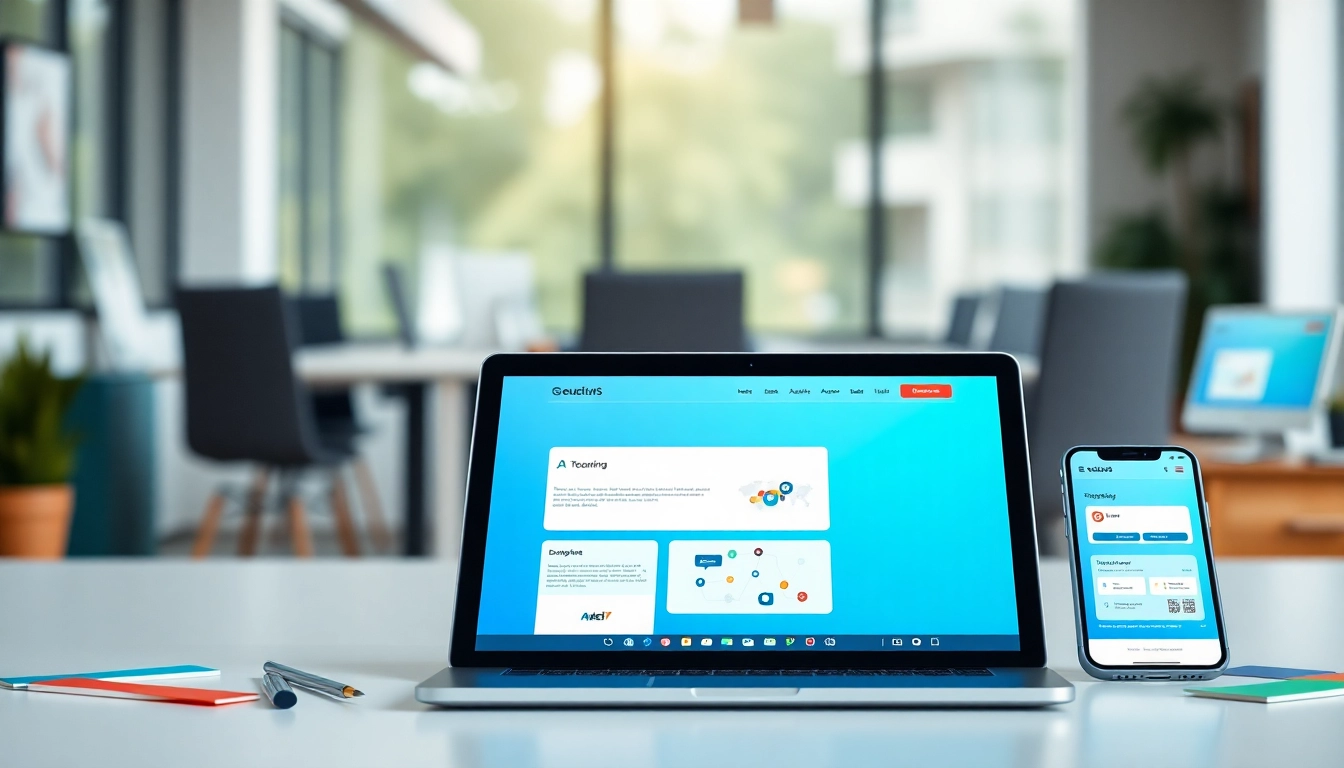Understanding the Basics of Website Design
What is Website Design?
Website design is a multifaceted discipline that involves the planning, creation, and maintenance of websites. It encompasses a variety of skills and disciplines, from graphic design to user interface design and authoring, including standardized code. This discipline combines both the aesthetics and functionality of a website to create an engaging experience for users.
The process of website design not only revolves around how a site looks visually but also how effectively it performs its intended function. Designers must consider the needs of users, the objectives of businesses, and the latest digital trends to create a cohesive and impactful online presence.
Core Components of Effective Website Design
An effective website design includes several core components:
- Layout: The arrangement of visual elements on a page. A well-organized layout guides visitors through the content seamlessly.
- Visual Elements: This includes colors, images, icons, and fonts, all of which contribute to the overall aesthetics and brand identity.
- Navigation: A clear and intuitive navigation structure is essential for users to find information quickly and easily.
- Content: The words, images, and videos that communicate your message and engage your audience.
- Functionality: Effective website design incorporates features like forms, shopping carts, and other interactive elements that enhance user experience.
Importance of User Experience in Website Design
User experience (UX) is at the forefront of website design. A website may look aesthetically pleasing, but if it doesn’t provide a smooth and enjoyable experience for the user, it could lead to higher bounce rates and lower conversion rates. By prioritizing user experience, designers can ensure that visitors can navigate the site easily, find the information they need, and ultimately engage with content or make purchases.
UX includes aspects like load times, mobile responsiveness, and overall usability. By conducting user testing and analyzing behavioral data, designers can identify pain points and opportunities for improvement, crafting websites that are not only functional but also enjoyable to use.
Key Principles to Follow in Website Design
Visual Hierarchy in Website Design
Visual hierarchy refers to the arrangement of elements in a way that signifies importance, guiding the user’s eye through the content. It involves using size, color, contrast, and spacing strategically to draw attention to certain elements. For example, headlines should be larger than body text, and important call-to-action buttons should stand out through color and placement.
Establishing a clear visual hierarchy helps users understand what action to take next, making it easier for them to engage with the website. This principle should be applied consistently across the entire site to maintain clarity and coherence.
Color Theory and Aesthetics in Website Design
Color plays a pivotal role in website design, affecting not only aesthetic appeal but also brand recognition and emotional responses. Understanding color theory can help designers choose a palette that resonates with their target audience while promoting usability and accessibility. Color combinations can elicit various psychological responses, making it essential to select colors that enhance the message and goals of the website.
For instance, a website promoting health and wellness might use calming greens and blues, while a creative portfolio might employ vibrant and eclectic colors to reflect artistry and innovation. Additionally, ensuring high contrast between text and background colors enhances readability and accessibility.
Typography Best Practices for Website Design
Typography is an often-underestimated aspect of website design that significantly affects readability and user experience. Selecting the right typefaces, font sizes, and line spacing can improve not only the aesthetics but the clarity of content as well.
Best practices include:
- Choosing readable typefaces for body text such as sans-serif fonts, which are generally cleaner and easier on screens.
- Limiting the number of different fonts to two or three to create a cohesive look.
- Utilizing font size and line height effectively to improve readability on various devices, ensuring a pleasant reading experience.
Advanced Techniques in Website Design
Responsive Website Design for All Devices
Responsive web design is crucial in today’s digital landscape as it allows websites to adjust their layout and content based on the screen size, orientation, and resolution of the device being used. This approach enhances user experience by presenting content in an optimal format, whether viewed on a desktop, tablet, or smartphone.
Implementing responsive design involves using fluid grids, flexible images, and media queries to ensure that all elements on the webpage adapt effectively. Testing across various devices and browsers is essential to identify any potential issues, ensuring that users have a seamless experience regardless of how they access the site.
Incorporating Interactive Elements into Website Design
Interactive elements, such as buttons, forms, animations, and hover effects, can significantly enhance user engagement on a website. These features encourage visitors to interact with content, improving their overall experience and driving conversions. Implementing interactive content can be particularly engaging in areas such as portfolios, product showcases, or educational websites.
However, it’s essential to strike a balance; excessive use of animations or elements that distract from the primary message can detract from usability. Careful planning and user testing are crucial to determine which interactive features best serve the website’s objectives.
SEO Factors to Consider in Website Design
Effective website design goes hand-in-hand with search engine optimization (SEO). Search engines take various factors into account when ranking websites, and certain design choices can significantly impact visibility. Key SEO considerations include:
- Site Speed: Fast-loading pages are favored by search engines and provide a better user experience.
- Mobile Optimization: Websites that are not optimized for mobile may suffer in search rankings.
- Structured Data: Implementing structured data helps search engines understand the content, improving the chances of higher rankings.
- SEO-Friendly URLs: Clean, descriptive URLs can enhance crawls and improve understandability for both users and search engines.
Tools and Resources for Effective Website Design
Popular Website Design Software and Platforms
Several tools and platforms are available that simplify the design process for both novices and experienced professionals. Some popular options include:
- Content Management Systems (CMS): Platforms like WordPress allow for extensive customization without the need for extensive coding knowledge.
- Design Software: Tools like Adobe XD and Figma are excellent for creating high-fidelity prototypes and mockups.
- Website Builders: Platforms that offer drag-and-drop functionality, such as Shopify or Webflow, can help users create professional-looking websites without extensive technical skills.
Utilizing Templates and Frameworks in Website Design
Templates and design frameworks provide a solid starting point for many website projects. They offer pre-designed layouts and components that can be modified to fit the specific needs of a business or individual. Utilizing templates not only accelerates the design process but also ensures that best practices are incorporated from the onset.
Frameworks like Bootstrap and Foundation facilitate responsive design, enabling developers to create sites that function seamlessly on a variety of devices. Templates can also help maintain consistency in branding and user experience across different sections of a website.
Finding Inspiration for Your Website Design
Inspiration is key in the creative process of website design. Several resources are available to spark creativity, including:
- Design Galleries: Websites such as Behance and Dribbble showcase work from designers around the world, offering a treasure trove of ideas and aesthetics.
- Trend Reports: Staying updated with the latest web design trends allows designers to incorporate modern practices, ensuring that their designs remain relevant.
- Competitor Analysis: Evaluating successful websites within the same industry provides critical insights and inspiration that can inform design decisions.
Measuring Success in Website Design
Key Performance Indicators for Website Design
To gauge the success of a website design, it is essential to define and track key performance indicators (KPIs). These metrics help determine how well the site meets its objectives. Common KPIs include:
- Traffic: Tracking visitor numbers and sources provides insights into the effectiveness of marketing efforts and overall site appeal.
- Bounce Rate: A high bounce rate might indicate that visitors are not finding what they expect.
- Conversion Rate: Measuring how many visitors complete desired actions (e.g., signing up for a newsletter or making a purchase) is critical for assessing effectiveness.
- Session Duration: Longer session durations can indicate strong engagement, whereas shorter sessions may suggest issues with content or usability.
User Feedback and Testing Methods in Website Design
Collecting user feedback is invaluable for enhancing website design. Techniques include surveys, usability testing, and direct feedback forms. Observing real users interacting with a site often uncovers pain points that may not be apparent during the design phases. A/B testing different design elements can also inform decisions on what works best.
Adjustment based on user insights continues to refine the design, ensuring that it meets audience needs while optimizing functionality and engagement.
Continuous Improvement Strategies for Website Design
Website design is not a one-time task; it requires ongoing assessment and improvement. Regular updates to content, features, and user interface elements help keep a site fresh and relevant. Following industry trends and technological advancements also informs necessary adjustments.
Establishing a routine for revisiting design elements, conducting performance evaluations, and implementing user feedback ensures that a website remains effective in meeting its goals, enhances user satisfaction, and strengthens its competitiveness in the market.








